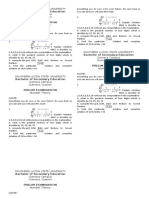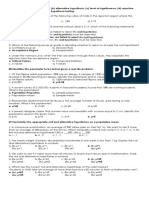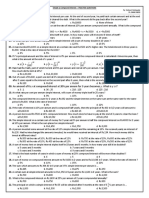The Measures of Variability
Uploaded by
Boyet AluanThe Measures of Variability
Uploaded by
Boyet AluanMeasurement and Evaluation
> >
Mr. Boyet B. Aluan
2
1 3
Q Q
Q
r
=
i
F
cf
N
LL Q
Q
LL
|
|
|
|
.
|
\
|
+ =
1
4
1 ( )
1
2
n
x x
SD
The Semi-interquartile Range
-measure of variability that divides a
distribution into four equal parts.
2
1 3
Q Q
Q
r
=
% 100
% 75
% 50
% 25
4
3
2
1
=
=
=
=
Q
Q
Q
Q
Inter-Quartile Range
- distance of score between two
quartiles.
i
F
cf
N
LL Q
Q
LL
|
|
|
|
.
|
\
|
+ =
1
4
1
i
F
cf b
N
LL Q
Q
LL
|
|
|
|
.
|
\
|
+ =
3
3
4
3
THE STANDARD DEVIATION
- is a measure which describes the
dispersion or spread of all scores in the
distribution rather than through extremely high or
low scores.
( )
1
2
=
n
x x
SD
Scores
5 5-7=-2
6 6-7=-1
7 7-7=0
8 8-7=1
9 9-7=2
n=5
x x
=35
= = 7
5
35
n
x
( )
58 . 1
5 . 2
4
10
1 5
10
1
2
=
=
=
=
SD
SD
SD
SD
n
x x
SD
Squared Deviation from the
mean.
( ) 10
4 2
1 1
0 0
1 1
4 2
2
2
2
2
2
2
=
=
=
=
=
=
x x
x x
The Measures of Variability in Various Distribution
1. homogeneous- when the SD is so small, scores
tend to cluster/compress toward the mean.
2. leptokurtic distribution- the groups tends to be
of almost the same ability.
KINDS OF DISTRIBUTION
1. HETEROGENEOUS-
Scores tends to spread away or
expanded from the mean.
2. PLATYKURTIC-
the class has different types of ability.
They spread evenly in the mean
symmetrically. Closed normal.
3. MESOKURTIC-
can only approximate. Similar to
normal curve. Bell shaped
You might also like
- Educational Measurement, Assessment and Evaluation100% (13)Educational Measurement, Assessment and Evaluation53 pages
- Statistics Measures of Position Worksheet 1No ratings yetStatistics Measures of Position Worksheet 14 pages
- Number Theory: Bachelor of Secondary EducationNo ratings yetNumber Theory: Bachelor of Secondary Education1 page
- Modern Geometry: Power Point PresentationNo ratings yetModern Geometry: Power Point Presentation20 pages
- Linear Algebra-4G Mid Term Exam Spring 2021No ratings yetLinear Algebra-4G Mid Term Exam Spring 20211 page
- Mathematics in The Modern World Midterm ExaminationNo ratings yetMathematics in The Modern World Midterm Examination2 pages
- Measure of Central Tendency Grouped DataNo ratings yetMeasure of Central Tendency Grouped Data10 pages
- Unit 4 Analysis and Interpretation of Assessment ResultsNo ratings yetUnit 4 Analysis and Interpretation of Assessment Results17 pages
- Module 2 - Mathematical Language and SymbolsNo ratings yetModule 2 - Mathematical Language and Symbols25 pages
- Measures of Central Tendency and VariabilityNo ratings yetMeasures of Central Tendency and Variability24 pages
- Math Subject For High School Probability and StatisticsNo ratings yetMath Subject For High School Probability and Statistics86 pages
- Welcome To Our Calculus 1 Subject: Lesson 3No ratings yetWelcome To Our Calculus 1 Subject: Lesson 314 pages
- Week 4: Laws of Exponent Multiplication and Division of Polynomia LsNo ratings yetWeek 4: Laws of Exponent Multiplication and Division of Polynomia Ls14 pages
- Statistics and Probability - Math - 7th grade by SlidesgoNo ratings yetStatistics and Probability - Math - 7th grade by Slidesgo16 pages
- Truth Tables Equivalent Statements Tautologies PDFNo ratings yetTruth Tables Equivalent Statements Tautologies PDF44 pages
- Simple & Compound Interest - Practice Questions100% (1)Simple & Compound Interest - Practice Questions2 pages
- Learning Module - Statistics and ProbabilityNo ratings yetLearning Module - Statistics and Probability123 pages
- Measures of Variability: Prof. Michelle M. Mag-IsaNo ratings yetMeasures of Variability: Prof. Michelle M. Mag-Isa46 pages
- Time Minutes Learning Areas: Morning SessionNo ratings yetTime Minutes Learning Areas: Morning Session8 pages
- Writing Essay Questions: Principles To Be Followed in Constructing EssayNo ratings yetWriting Essay Questions: Principles To Be Followed in Constructing Essay2 pages
- I PUC MID TERM STATS MODEL QUESTION PAPER[1]No ratings yetI PUC MID TERM STATS MODEL QUESTION PAPER[1]3 pages
- Mcq-On-Linear-Regression - 5eea6a0b39140f30f369dd1cNo ratings yetMcq-On-Linear-Regression - 5eea6a0b39140f30f369dd1c22 pages
- pmwj27 Oct2014 Wain Updating The Lang Factor Featured Paper PDFNo ratings yetpmwj27 Oct2014 Wain Updating The Lang Factor Featured Paper PDF17 pages
- 1.1 Parametric and Nonparametric Statistical InferenceNo ratings yet1.1 Parametric and Nonparametric Statistical Inference8 pages
- 2024 CFA© Program Curriculum Level II Volume 1 Quantitative Methods, Economics 1st Edition Cfa Institute all chapter instant download100% (25)2024 CFA© Program Curriculum Level II Volume 1 Quantitative Methods, Economics 1st Edition Cfa Institute all chapter instant download50 pages
- Estimating Long Run Effects in Models With Cross-Sectional Dependence Using Xtdcce2No ratings yetEstimating Long Run Effects in Models With Cross-Sectional Dependence Using Xtdcce237 pages
- Analysis of HDFC, Icici Opening and Closing Maximum Share PriceNo ratings yetAnalysis of HDFC, Icici Opening and Closing Maximum Share Price33 pages
- BurkeyAcademy Spatial Regression CheatSheet 0.65No ratings yetBurkeyAcademy Spatial Regression CheatSheet 0.652 pages
- Aditya Surya Pratama 36B - Tugas StatistikNo ratings yetAditya Surya Pratama 36B - Tugas Statistik22 pages
- Inferential Statistics: Estimation and Confidence IntervalsNo ratings yetInferential Statistics: Estimation and Confidence Intervals19 pages
- AP Stat - Test 9 (Chapters 19-24) - 2005-2006No ratings yetAP Stat - Test 9 (Chapters 19-24) - 2005-20064 pages
- Diversity and Inclusion Survey Analysis 19th SepNo ratings yetDiversity and Inclusion Survey Analysis 19th Sep8 pages
- Rocinante 36 Marengo 32 Mileage (KM/LTR) Top Speed (KM/HR) Mileage (KM/LTR) Top Speed (KM/HR)No ratings yetRocinante 36 Marengo 32 Mileage (KM/LTR) Top Speed (KM/HR) Mileage (KM/LTR) Top Speed (KM/HR)3 pages
- Educational Measurement, Assessment and EvaluationEducational Measurement, Assessment and Evaluation
- Mathematics in The Modern World Midterm ExaminationMathematics in The Modern World Midterm Examination
- Unit 4 Analysis and Interpretation of Assessment ResultsUnit 4 Analysis and Interpretation of Assessment Results
- Math Subject For High School Probability and StatisticsMath Subject For High School Probability and Statistics
- Week 4: Laws of Exponent Multiplication and Division of Polynomia LsWeek 4: Laws of Exponent Multiplication and Division of Polynomia Ls
- Statistics and Probability - Math - 7th grade by SlidesgoStatistics and Probability - Math - 7th grade by Slidesgo
- Truth Tables Equivalent Statements Tautologies PDFTruth Tables Equivalent Statements Tautologies PDF
- Measures of Variability: Prof. Michelle M. Mag-IsaMeasures of Variability: Prof. Michelle M. Mag-Isa
- Writing Essay Questions: Principles To Be Followed in Constructing EssayWriting Essay Questions: Principles To Be Followed in Constructing Essay
- Mcq-On-Linear-Regression - 5eea6a0b39140f30f369dd1cMcq-On-Linear-Regression - 5eea6a0b39140f30f369dd1c
- pmwj27 Oct2014 Wain Updating The Lang Factor Featured Paper PDFpmwj27 Oct2014 Wain Updating The Lang Factor Featured Paper PDF
- 1.1 Parametric and Nonparametric Statistical Inference1.1 Parametric and Nonparametric Statistical Inference
- 2024 CFA© Program Curriculum Level II Volume 1 Quantitative Methods, Economics 1st Edition Cfa Institute all chapter instant download2024 CFA© Program Curriculum Level II Volume 1 Quantitative Methods, Economics 1st Edition Cfa Institute all chapter instant download
- Estimating Long Run Effects in Models With Cross-Sectional Dependence Using Xtdcce2Estimating Long Run Effects in Models With Cross-Sectional Dependence Using Xtdcce2
- Analysis of HDFC, Icici Opening and Closing Maximum Share PriceAnalysis of HDFC, Icici Opening and Closing Maximum Share Price
- Inferential Statistics: Estimation and Confidence IntervalsInferential Statistics: Estimation and Confidence Intervals
- Rocinante 36 Marengo 32 Mileage (KM/LTR) Top Speed (KM/HR) Mileage (KM/LTR) Top Speed (KM/HR)Rocinante 36 Marengo 32 Mileage (KM/LTR) Top Speed (KM/HR) Mileage (KM/LTR) Top Speed (KM/HR)

































































































